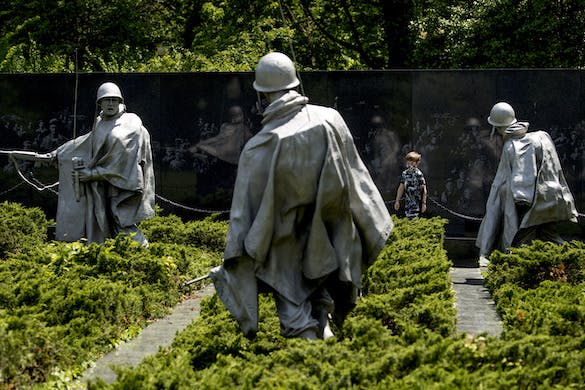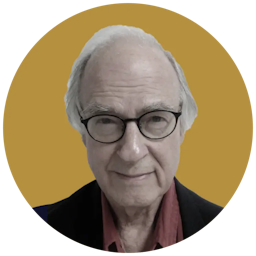Koreans Who Served Alongside Americans Earn Place of Honor on National Mall Memorial
‘This started as a dream of the Korean War veterans,’ General Tilelli said, and the Koreans are paying the entire $22 million cost of rebuilding and greatly enlarging the memorial.

WASHINGTON – They fought as members of American military units and died with Americans in a war that lasted for more than three years. Now they’re being honored just like the Americans on a “wall of remembrance” of a vicious conflict that surged back and forth before ending in an uneasy armistice on July 27, 1953.
The role of the Korean Augmentation to the United States Army was recognized Friday in a ceremony on the National Mall at Washington in which Kim Hae-sung, chairman of the Katusa Veterans Association of Korea, presented a $50,000 donation for the Korean War Veterans Memorial Foundation to General Vincent Brooks, who wound up his career as the military commander in Korea in 2018.
“We served together,” General Brooks said. “We honor the memory of those who served.”
Another retired general, John Tilelli, commander in Korea between 1996 and 1999, talked proudly about the memorial in which the names of more than 7,600 Katusas are etched on the Wall of Remembrance along with those of 36,164 Americans who also died in the war.
“This memorial is a big deal, and the Korean government is paying for it,” General Tilelli said. He visits two or three times a week, often in work clothes, to make sure the entire memorial is gleaming and ready for its official opening on July 27, which will mark 69 years since the truce was signed.
“This started as a dream of the Korean War veterans,” he said, and the Koreans are covering the entire $22 million cost of rebuilding and greatly enlarging the memorial, which opened for the first time on July 27, 1995.
The most dramatic enhancement is the Wall of Remembrance naming all those who died in American units — as does the Vietnam War Memorial Wall that opened on the mall a few hundred yards away in November 1982.
General Tilelli, who served two tours in Vietnam, wasn’t fazed by a reminder that the Korean War memorial opened 13 years after the Vietnam War memorial even though the Korean War had ended 12 years before the first American combat troops plunged into Vietnam in 1965.
Nor did he seem to mind that sightseers at the Korean War memorial might be tempted to say that it’s imitating the Vietnam memorial, perpetuating the legacy of those who died by engraving their names in stone. “Let them say what they want,” he said.
The real point is that no other memorial for any American war has included the names of the foreign troops who served alongside them in the same units.
The reason is that the Katusas, as they are universally known, occupy a unique place in the annals of American military history. Although members of the Korean armed forces, they were under U.S. command, working with Americans, not Koreans, and were treated as though they were American troops. That places them in an entirely different category from another 100,000 or so South Koreans soldiers who were killed serving in South Korean units.
The 7,600 Korean names on the Wall of Remembrance are right there in alphabetical order with the Americans. The most common Korean surnames are reflected in the dozen columns of soldiers named Kim and the eight of Lee.
The occasion provided a tremendous opportunity for Korean military veterans, including about 20 who had flown here from Seoul, to affirm the need to stand up to North Korean threats. All were too young to have served in the Korean War but were heartened by the election of a conservative, Yoon Suk-yeol, as Korea’s president. He’s to be inaugurated May 10 as successor to Moon Jae-in, the liberal president.
Members of the Korean Veterans Association “have great pride and appreciation that the names of the honorable war veterans are getting engraved on the wall,” Kim Hae-sung said. “I am overwhelmed with emotion for standing at this very moment right at this Wall of Remembrance. The names of the 43,760 Americans and Koreans who fought in the same units will now be remembered by all” — proof, he said, that “their sacrifice has not been in vain.”
By curious coincidence, as the ceremony was being held beneath clear blue skies on a pleasant spring day, North Koreans at night in Pyongyang, 13 hours ahead of EDT, were marking the 110th anniversary of the birth of the regime’s founder, Kim Il-sung, grandfather of the current North Korean leader, Kim Jong-un.
Kim Jong-un appeared “amid the playing of the welcome music,” said Pyongyang’s Korean Central News Agency. “All the participants raised stormy cheers of ‘Hurrah!’ for him along with fireworks let off and balloons released. He extended a warm greeting to all the people celebrating the significant Day of the Sun with high political enthusiasm and proud labor successes, warmly waving back to the loudly cheering crowds.”
At the National Mall, Yoon Yoon-Soo, who has served as chairman of Fila, the sportswear manufacturer, since taking it over 25 years ago, said “the establishment of this wall is not just about the construction of sculptures.”
Rather, the adviser to the Katusa Veterans Association said, “It should be a symbol of solidarity and alliance, confirming the close cooperation between our two countries going forward,” and “remembered as a monument for peace.” America and South Korea, he said, should “take the same path together,” showing “why they call it a blood alliance.”

